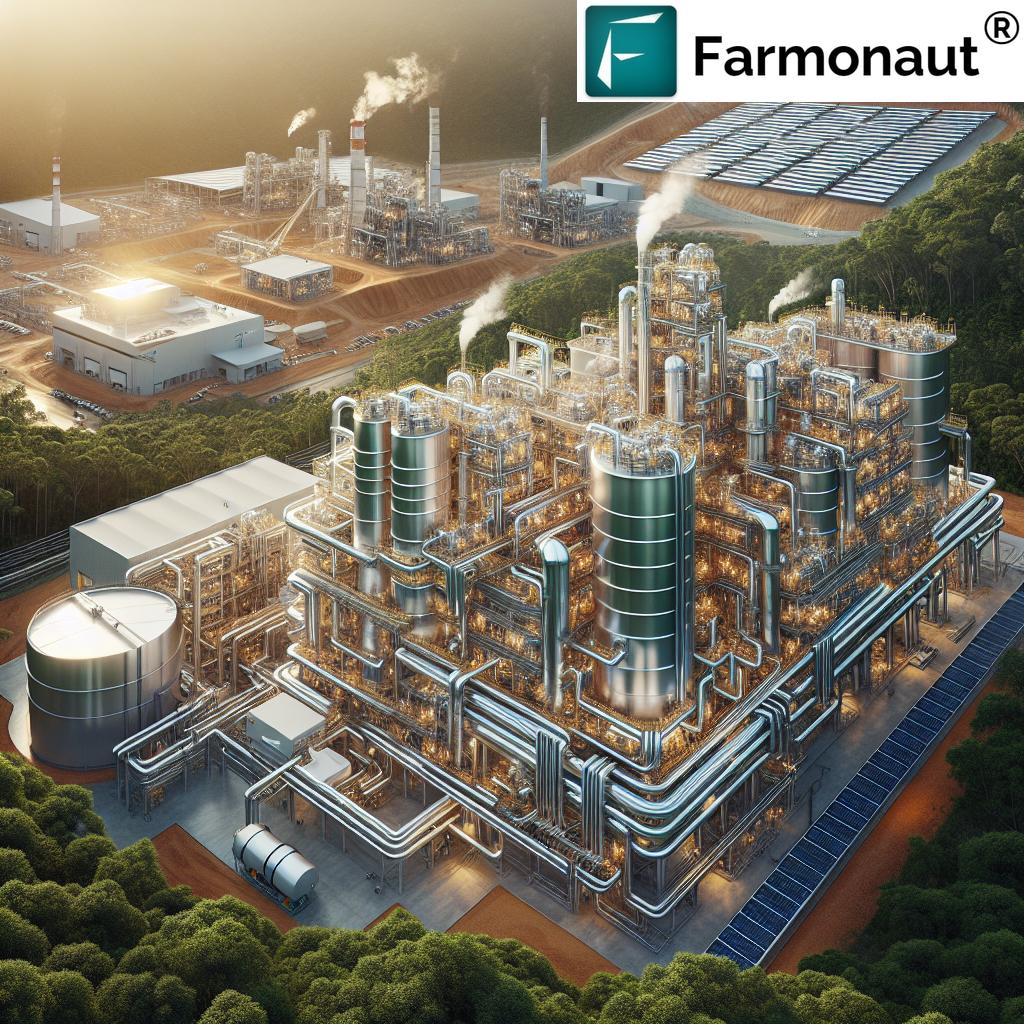Sustainable Gold Mining: How Australia’s Sodium Cyanide Expansion Boosts Production and Cuts Emissions

“Australia’s sodium cyanide facility expansion will increase production capacity by 30%, reaching 130,000 tonnes annually.”
In the realm of sustainable gold mining, a groundbreaking development is set to reshape the industry’s landscape. We are witnessing a significant expansion of a major sodium cyanide production facility in Western Australia, a move that promises to boost global gold mining sustainability while simultaneously increasing production capacity. This strategic initiative not only addresses the growing international demand for sodium cyanide but also sets new benchmarks for environmental stewardship in the mining sector.
The Expansion: A Leap Towards Sustainable Production
On February 8, 2025, Australian Gold Reagents (AGR) announced a monumental expansion of its sodium cyanide production facility in Kwinana, Western Australia. This decision is a direct response to the escalating global demand for sodium cyanide, a crucial component in gold extraction processes. The expansion is set to position AGR as one of the world’s leading sodium cyanide producers for the gold mining industry.
General Manager Barney Jones highlighted the significance of this expansion, stating that it will increase the company’s sodium cyanide production capacity by over 30%, reaching an impressive 130,000 tonnes per annum. This substantial boost includes enhancements to solid production capabilities, facilitating increased exports to AGR’s international client base.
Key aspects of the expansion include:
- Increased annual production capacity to 130,000 tonnes
- Enhanced solid production capabilities for international exports
- Integration with existing infrastructure for improved operational efficiencies
- Implementation of cutting-edge technology for industrial decarbonization
This expansion is not just about increasing numbers; it’s a strategic response to the evolving needs of gold producers across Australia and diverse regions including Asia, Africa, the Americas, and the Middle East. By bolstering its production capacity, AGR is positioning itself as a reliable partner in the global gold mining supply chain.
Embracing Sustainable Mining Practices
At the heart of this expansion lies a commitment to sustainable mining practices. AGR’s initiative goes beyond mere production increase; it encompasses a holistic approach to reducing environmental impact and promoting sustainability in the gold mining industry.
“The expansion project aims to reduce greenhouse gas emissions intensity by 28% and recycle over 70% of wastewater onsite.”
Let’s delve into the key sustainability features of this expansion:
1. Low-Emissions Incinerator
A cornerstone of AGR’s sustainability efforts is the installation of a state-of-the-art, low-emissions incinerator. This advanced technology is designed to responsibly dispose of waste products from the manufacturing process while significantly reducing greenhouse gas emissions. The projected outcome is impressive – a 28% decrease in AGR’s greenhouse gas emissions intensity.
2. Advanced Wastewater Management
The expanded facility will showcase cutting-edge wastewater management practices. Plans are in place to recycle over 70% of wastewater onsite, a move that will conserve valuable water resources and reduce dependency on external water supplies. This approach not only aligns with sustainable water management principles but also sets a new standard for resource efficiency in the mining industry.
3. Clean Energy Generation
In an innovative approach to energy management, AGR is exploring technologies to harness waste heat from production processes. This initiative aims to generate zero-emissions electricity, potentially allowing the plant to export clean energy to neighboring facilities or contribute to the local power grid. This forward-thinking approach exemplifies AGR’s commitment to sustainable energy solutions in mining operations.
These sustainability initiatives are not just beneficial for the environment; they also position AGR as a leader in responsible resource extraction, setting a new benchmark for the industry.
Impact on Global Gold Mining
The expansion of AGR’s sodium cyanide production facility is set to have far-reaching implications for the global gold mining industry. As we move towards more sustainable gold extraction methods, the availability of eco-friendly sodium cyanide becomes crucial.
Here’s how this expansion is likely to impact the industry:
- Increased supply of sodium cyanide to meet growing global demand
- Support for sustainable gold extraction processes worldwide
- Potential for reduced environmental footprint in gold mining operations
- Encouragement of similar sustainability initiatives in other mining supply chains
By providing a more sustainable source of sodium cyanide, AGR is enabling gold mining companies around the world to improve their environmental performance without compromising on production capacity.
Technological Advancements in Mining: A Parallel Development
While AGR’s expansion focuses on sustainable sodium cyanide production, it’s worth noting the parallel advancements in mining technology that complement these efforts. For instance, companies like Farmonaut are revolutionizing agriculture and land management practices with satellite-based solutions.
Although Farmonaut’s primary focus is agriculture, its technologies offer valuable insights for land management practices that could be applicable in mining contexts. Their use of satellite imagery and AI for monitoring vegetation health and soil moisture levels could potentially be adapted for monitoring mining sites and their environmental impact.
While Farmonaut is not directly involved in mining operations, their innovative approach to land management and sustainability aligns with the broader goals of responsible resource extraction that AGR’s expansion embodies.
The Role of Government Support in Industrial Decarbonization
A crucial aspect of AGR’s expansion project is the support it has received from the Australian Government. The project has been partially funded through a $7.5 million Powering the Regions Fund grant, aimed at supporting industrial decarbonization efforts. This government backing underscores the importance of public-private partnerships in driving sustainable industrial practices.
The grant not only provides financial support but also signals a strong commitment from the Australian Government to promote cleaner, more sustainable industrial processes. This kind of support is essential for encouraging other companies in the mining and related industries to invest in eco-friendly technologies and practices.
Timeline and Implementation
The expansion project is well underway, with a clear timeline for implementation:
- Engineering design is currently progressing
- Long lead items have already been ordered
- First production from the expanded facility is anticipated in FY2026
- Full operational capacity is expected to be realized in the latter half of FY2027
This phased approach allows for a smooth transition and integration of new technologies and processes, ensuring minimal disruption to ongoing operations while maximizing the benefits of the expansion.
The Business Perspective: AGR’s Strategic Position
From a business standpoint, AGR’s expansion is a strategic move that strengthens its position in the global sodium cyanide market. Operating as a joint venture in sodium cyanide production, with CSBP (part of Wesfarmers Chemicals, Energy and Fertilisers) holding a 75% ownership stake, AGR is well-positioned to leverage this expansion for significant market growth.
CSBP’s role as the operating and sales agent for the venture further reinforces AGR’s commitment to providing reliable sodium cyanide supplies to the gold mining industry globally. This structure ensures a strong operational foundation and extensive market reach.
| Metric | Before Expansion | After Expansion |
|---|---|---|
| Annual Production Capacity (tonnes) | 100,000 (estimated) | 130,000 |
| Greenhouse Gas Emissions Intensity (% reduction) | Baseline | 28% reduction |
| Wastewater Recycling (% recycled onsite) | Not specified | Over 70% |
| Clean Energy Generation (potential MW output) | None | To be determined (potential for export) |
| Global Gold Mining Sustainability Impact | Standard industry practices | Significant improvement in sustainability and efficiency |
Environmental Stewardship in Mining: A New Era
The AGR expansion project marks a significant milestone in environmental stewardship within the mining industry. By integrating advanced technologies for emissions reduction, wastewater management, and potential clean energy generation, AGR is setting a new standard for sustainable operations in the sector.
This approach to environmental stewardship goes beyond mere compliance with regulations; it represents a proactive stance towards minimizing the ecological footprint of mining-related activities. The potential ripple effects of these practices could inspire similar initiatives across the global mining industry, leading to a collective shift towards more sustainable operations.
The Future of Sustainable Gold Mining
As we look to the future, the AGR expansion project offers a glimpse into what sustainable gold mining might look like. The integration of eco-friendly technologies in sodium cyanide production is just one piece of the puzzle. The industry is likely to see further innovations in areas such as:
- Water conservation and recycling in mining operations
- Energy-efficient extraction methods
- Rehabilitation of mining sites
- Circular economy practices in resource utilization
These advancements, coupled with initiatives like AGR’s expansion, paint a promising picture of a more sustainable and responsible gold mining industry.
Explore Farmonaut’s API for advanced satellite data integration
Global Market Implications
The expansion of AGR’s sodium cyanide production capacity is set to have significant implications for the global gold mining market. With increased production and more sustainable practices, we can expect:
- More stable supply of sodium cyanide for gold producers worldwide
- Potential for reduced costs in gold extraction processes
- Increased competitiveness of gold mining operations using sustainable practices
- Growing demand for eco-friendly mining solutions in emerging markets
These market shifts could lead to a more resilient and sustainable gold mining industry, better equipped to meet the challenges of the 21st century.
Challenges and Opportunities
While the expansion project presents numerous benefits, it’s important to acknowledge the challenges that come with such a significant undertaking:
- Initial capital investment for new technologies and infrastructure
- Potential short-term disruptions during the implementation phase
- Need for workforce training in new technologies and processes
- Ongoing monitoring and adjustment of new systems for optimal performance
However, these challenges also present opportunities for innovation, skill development, and industry leadership. By successfully navigating these hurdles, AGR and similar companies can pave the way for widespread adoption of sustainable practices in the mining industry.
The Role of Technology in Sustainable Mining
Technology plays a crucial role in enabling sustainable mining practices. While AGR’s expansion focuses on sodium cyanide production, it’s worth noting how other technological advancements are contributing to sustainability in the broader mining sector.
Check out Farmonaut’s API Developer Docs for insights into satellite data utilization
For instance, satellite technology, similar to what Farmonaut uses in agriculture, is being adapted for mining applications. These technologies can help in:
- Monitoring environmental impact of mining operations
- Optimizing resource extraction processes
- Enhancing safety measures in mining sites
- Improving overall operational efficiency
While Farmonaut’s focus is on agriculture, the principles of using satellite data and AI for land management could potentially be adapted for mining contexts, further contributing to the industry’s sustainability efforts.
Sustainable Supply Chains in Mining
AGR’s expansion project highlights the importance of sustainable supply chains in the mining industry. By producing sodium cyanide more sustainably, AGR is contributing to the overall sustainability of the gold mining supply chain. This approach aligns with growing global trends towards responsible sourcing and production.
Key aspects of sustainable supply chains in mining include:
- Reducing carbon footprint throughout the supply chain
- Implementing ethical sourcing practices
- Enhancing transparency in production and distribution
- Collaborating with partners who share sustainability goals
As more companies adopt these practices, we can expect to see a ripple effect throughout the industry, leading to more sustainable and responsible mining operations globally.
The Economic Impact of Sustainable Mining Practices
The shift towards sustainable mining practices, as exemplified by AGR’s expansion, has significant economic implications. While the initial investment in eco-friendly technologies and processes may be substantial, the long-term benefits are considerable:
- Reduced operational costs through improved resource efficiency
- Enhanced brand value and market position due to sustainable practices
- Potential access to green financing and sustainability-linked loans
- Improved relationships with local communities and regulatory bodies
These economic benefits demonstrate that sustainability and profitability can go hand in hand in the mining industry.
Global Collaboration for Sustainable Mining
The AGR expansion project serves as a model for global collaboration in sustainable mining practices. As the industry moves towards more environmentally friendly operations, international cooperation becomes increasingly important. This collaboration can take various forms:
- Sharing best practices and technological innovations
- Joint research and development initiatives
- Standardization of sustainability metrics and reporting
- Cross-border partnerships for sustainable supply chains
By fostering such collaborations, the mining industry can accelerate its transition towards more sustainable practices on a global scale.
The Future of Mining: Balancing Production and Sustainability
As we look to the future, the AGR expansion project represents a significant step towards balancing increased production with environmental sustainability in the mining industry. This balance is crucial for the long-term viability of the sector and its ability to meet global resource demands responsibly.
Key aspects of this balanced approach include:
- Continuous innovation in eco-friendly extraction and production methods
- Integration of renewable energy sources in mining operations
- Development of circular economy practices in resource utilization
- Enhanced focus on biodiversity conservation and land rehabilitation
By embracing these principles, the mining industry can continue to meet global demand while minimizing its environmental impact.
Conclusion: A New Era in Sustainable Gold Mining
The expansion of AGR’s sodium cyanide production facility in Western Australia marks a significant milestone in the journey towards sustainable gold mining. By boosting production capacity while simultaneously reducing environmental impact, AGR is setting a new standard for the industry.
This initiative demonstrates that increased production and environmental stewardship can go hand in hand, paving the way for a more sustainable future in gold mining. As other companies follow suit, we can expect to see a transformation in the industry, characterized by reduced emissions, improved resource efficiency, and enhanced environmental performance.
The future of gold mining is not just about extracting precious metals from the earth; it’s about doing so in a way that respects our planet and ensures the long-term sustainability of our resources. AGR’s expansion project is a shining example of how innovation, technology, and commitment to sustainability can lead the way in this new era of responsible mining.
FAQ Section
- Q: What is the main goal of AGR’s sodium cyanide production facility expansion?
A: The main goal is to increase production capacity by 30% to meet growing global demand while implementing sustainable practices to reduce environmental impact. - Q: How will this expansion affect greenhouse gas emissions?
A: The expansion aims to reduce greenhouse gas emissions intensity by approximately 28% through the implementation of new technologies, including a low-emissions incinerator. - Q: What improvements are being made in wastewater management?
A: The expanded facility plans to recycle over 70% of wastewater onsite, significantly reducing dependency on external water supplies. - Q: Is there any government support for this expansion project?
A: Yes, the project has received partial funding from the Australian Government through a $7.5 million Powering the Regions Fund grant, aimed at supporting industrial decarbonization efforts. - Q: When is the expanded facility expected to be fully operational?
A: First production from the expanded facility is anticipated in FY2026, with full operational capacity expected to be realized in the latter half of FY2027. - Q: How does this expansion contribute to sustainable gold mining practices?
A: By providing a more sustainable source of sodium cyanide, the expansion enables gold mining companies worldwide to improve their environmental performance without compromising on production capacity. - Q: What are the potential global impacts of this expansion?
A: The expansion is expected to stabilize the global supply of sodium cyanide, potentially reduce costs in gold extraction processes, and encourage the adoption of more sustainable practices in the gold mining industry worldwide.







